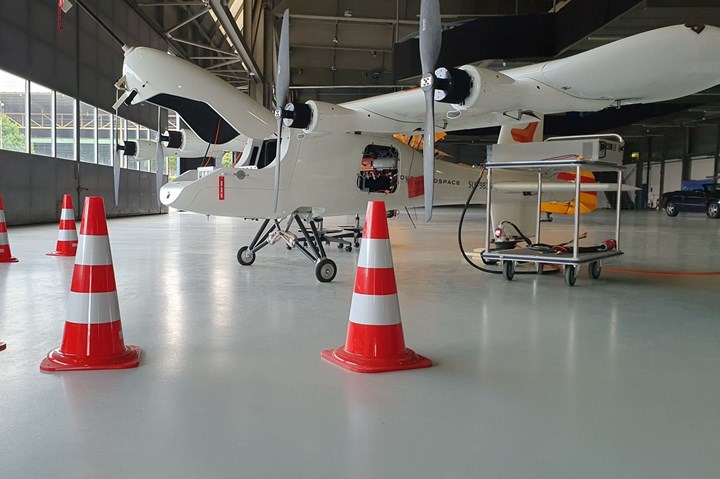Dufour Aerospace announces composites airframe, nacelle and tail suppliers for Aero2 drone prototype
The uncrewed, hybrid-electric, tilt-wing cargo transport aircraft will feature an all-composite airframe and composites-intensive nacelle and tail.

Photo Credit, all images: Dufour Aerospace
This summer, electric vertical takeoff and landing (eVTOL) company Dufour Aerospace (Zurich, Switzerland) released the final specifications for its uncrewed, hybrid-electric, tilt-wing Aero2 drone, as well as the selection of key suppliers Connova AG (Ennetbürgen, Switzerland) for the composite airframe and Aerolite AG (Horw, Switzerland) for composite structural components in the nacelles and tail.
Since its original prototype, the design for Aero2 has evolved from a conventional tail to an H-tail with a larger fuselage and wingspan and a wing profile optimized for its likely missions, such as critical goods transport, aerial surveying beyond visual line of sight (BVLOS) and public safety applications.
The Aero2 aircraft is expected to be able to transport 40 kilograms over a distance of 400 kilometers. It will serve as a precursor to the Aero3, a larger tilt-wing aircraft which could support options for uncrewed or crewed operations.
The release of final production specifications follows successive recent announcements from Dufour Aerospace. In May, the company announced it had been selected for a grant of CHF 2.5 million ($2.8 million) from Innosuisse, the innovation agency of the Swiss Confederation. In January, the company closed a Series B financing round led by Vista Global. In late 2022, Dufour announced the largest civilian drone purchase in U.S. history, made with Spright, the drone division of Air Methods. Spright will purchase 40 Aero2 with options for an additional 100 units.
Dufour Aerospace is now ordering materials required to build X2.3, the last Aero2 prototype before the entry-into-service aircraft. X2.3 will be able to demonstrate the full flight envelope and the performance of the hybrid system. Flight testing of X2.3 is expected to start early in 2024. The start of series production of Aero2 is planned for 2025.
All-composite airframe, produced by Connova AG
According to Dufour Aerospace, the all-composite lightweight airframe is a key contributor to the Aero2’s performance. Connova AG will produce the major subassemblies for the Aero2 airframe main wing, fuselage and engine bay at its production site in Villmergen, Switzerland.
“Connova has a wealth of experience and knowledge as an established composite manufacturer to the aerospace and automotive industry. In making the wings for Dufour’s current Aero2 experimental flight test aircraft to a new patent-pending design and manufacturing method, Connova has demonstrated the diligence and professionalism required to assure the high standards of quality necessary to deliver light weight aircraft structures,” says Simon Bendrey, head of design at Dufour Aerospace.
“We strongly believe in the success of the aircraft and are willing to increase our production capacities with the growing demand by Dufour Aerospace in the upcoming years,” says Taylan Toprak, head of sales and project management at Connova.
Composite nacelle and tail components, produced by Aerolite AG
For the first phase of Dufour Aerospace’s collaboration with Aerolite AG, Aerolite will produce and delivery the nacelle and tail structure components for the Aero2 prototype aircraft. The company is also being considered for production of the subsequent serial aircraft.
According to Dufour Aerospace, weight reduction is one of the keys to success for aviation engineering, and Aerolite was selected for its years of experience producing solid yet lightweight solutions as a supplier to the aviation industry.
Related Content
Manufacturing the MFFD thermoplastic composite fuselage
Demonstrator’s upper, lower shells and assembly prove materials and new processes for lighter, cheaper and more sustainable high-rate future aircraft.
Read MorePlant tour: Joby Aviation, Marina, Calif., U.S.
As the advanced air mobility market begins to take shape, market leader Joby Aviation works to industrialize composites manufacturing for its first-generation, composites-intensive, all-electric air taxi.
Read MoreNext-generation airship design enabled by modern composites
LTA Research’s proof-of-concept Pathfinder 1 modernizes a fully rigid airship design with a largely carbon fiber composite frame. R&D has already begun on higher volume, more automated manufacturing for the future.
Read MoreComposites manufacturing for general aviation aircraft
General aviation, certified and experimental, has increasingly embraced composites over the decades, a path further driven by leveraged innovation in materials and processes and the evolving AAM market.
Read MoreRead Next
Developing bonded composite repair for ships, offshore units
Bureau Veritas and industry partners issue guidelines and pave the way for certification via StrengthBond Offshore project.
Read MorePlant tour: Daher Shap’in TechCenter and composites production plant, Saint-Aignan-de-Grandlieu, France
Co-located R&D and production advance OOA thermosets, thermoplastics, welding, recycling and digital technologies for faster processing and certification of lighter, more sustainable composites.
Read More“Structured air” TPS safeguards composite structures
Powered by an 85% air/15% pure polyimide aerogel, Blueshift’s novel material system protects structures during transient thermal events from -200°C to beyond 2400°C for rockets, battery boxes and more.
Read More
.jpg;width=70;height=70;mode=crop)
















.jpg;maxWidth=300;quality=90)









